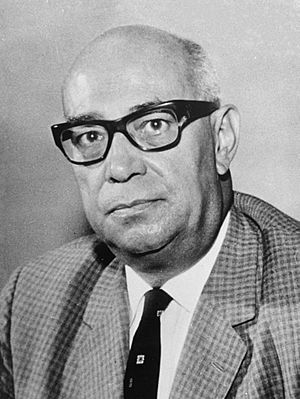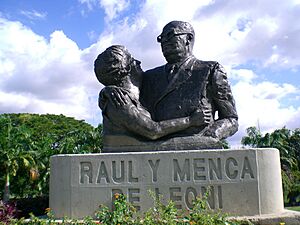Raúl Leoni facts for kids
Quick facts for kids
Raúl Leoni
|
|
|---|---|
 |
|
| President of Venezuela | |
| In office 13 March 1964 – 11 March 1969 |
|
| Preceded by | Rómulo Betancourt |
| Succeeded by | Rafael Caldera |
| Senator for life | |
| In office 11 March 1969 – 5 July 1972 |
|
| President of the Senate of Venezuela | |
| In office 1959–1962 |
|
| Preceded by | Carlos R. Travieso |
| Succeeded by | Luis Beltrán Prieto Figueroa |
| Minister of Labor of Venezuela | |
| In office 1945–1948 |
|
| Personal details | |
| Born |
Raúl Leoni Otero
26 April 1905 El Manteco, Bolívar State, Venezuela |
| Died | 5 July 1972 (aged 67) New York City, New York, U.S. |
| Political party | Acción Democrática |
| Spouse | Carmen América Fernández Alcalá (Menca de Leoni) |
| Children | 1 |
| Signature | |
Raúl Leoni Otero (born April 26, 1905 – died July 5, 1972) was an important leader in Venezuela. He served as the President of Venezuela from 1964 to 1969. He was also one of the first members of the Acción Democrática political party. Before becoming president, he was Venezuela's first Minister of Labor.
Contents
Early Life and Education
Leoni was born in El Manteco, a town in Bolívar State. His father, Clement Leoni Scribani, was from Corsica. Raúl Leoni studied law at the Central University of Venezuela in Caracas. He became a lawyer.
He was part of a group called the "Generation of 1928". This group included young students who protested against the government at the time.
Leoni's Time as President
Raúl Leoni became president on March 13, 1964. He took over from Rómulo Betancourt. Both were members of the Acción Democrática party.
Working with Other Parties
During his presidency, Leoni worked to keep political peace in Venezuela. There was an agreement called the Pacto de Punto Fijo. This agreement said that the government's main team should include members from the three most important political parties. These parties were Acción Democrática (AD), COPEI, and Unión Republicana Democrática (URD).
Leoni first chose a team with many independent people, not just party members. But later, in November 1964, he talked with party leaders. They formed a new government team that followed the agreement. This helped different political groups work together.
Major Projects and Changes
Leoni's government started many important projects across Venezuela. They focused on building up heavy industries in the Guayana region. This included projects for hydroelectric power and making iron and steel.
His government also opened the Bank of the Workers. They built new roads, highways, and bridges. One very important bridge crossed the Orinoco River.
There were also big changes in labor and social programs. Workers' unions became stronger. The Social Security law, which helps people with healthcare and other benefits, was updated.
Dealing with Challenges
During Leoni's time as president, there was a conflict with a group called the Armed Forces for National Liberation (FALN). This was a leftist group that used armed force against the government. Leoni's government worked to stop this conflict. The army was given power to deal with the situation.
Other countries, like Cuba, tried to help these groups in Venezuela. In 1966, a Cuban officer came to Venezuela to check on the groups. In 1967, there was an event called the Machurucuto raid. Some Cubans and Venezuelans tried to enter Venezuela to help the groups.
Leoni spoke out against this. He showed two captured Cubans and accused Cuba of interfering in Venezuela. Venezuela reported Cuba to the Organization of American States. Because of this, Venezuela stopped having relations with Cuba until 1974. This helped end Cuba's involvement in Venezuelan affairs.
International Agreements
Leoni also signed the Cartagena Agreement. This was an important step towards creating a trade bloc (a group of countries that trade freely with each other). This agreement was signed in Bogotá with Venezuela, Chile, Colombia, Peru, and Ecuador. It was a step towards the Andean Community.
Peaceful Transfer of Power
On March 11, 1969, Leoni peacefully handed over power to Rafael Caldera. Caldera was a member of the Christian Democratic Party COPEI. He was also one of the people who signed the Pacto de Punto Fijo. This peaceful transfer of power between different parties became a regular thing in Venezuela for many years.
Personal Life and Passing
Raúl Leoni was married to Carmen América Fernández. She was the First Lady of Venezuela during his presidency (1964–1969). They had one son named Álvaro.
Leoni passed away on July 5, 1972, at the age of 67. He was in New York City at the Cornell Medical Center. He had been recovering from medical treatment after experiencing a hemorrhage.
See also
 In Spanish: Raúl Leoni para niños
In Spanish: Raúl Leoni para niños


